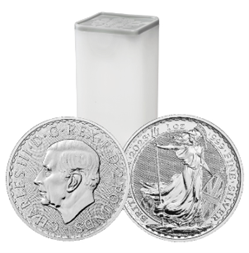Before diving into what was recently announced by the Institute of International Finance (IIF), it is important to understand the glaring difference between the financial system the world finds itself in today and a system that is built upon sound money, silver and gold.
When looking at how the system operates today, it is entirely based on the issuance of new debt or credit, and the ability for citizens, businesses, and governments alike to acquire cheap currency to allow for the debt to be serviced in a manageable way. Where as, a system that is based on silver and gold is a system that is focused on real value. The difference is a debt-based system fuels incredible risk because new currency can be rapidly printed to bail out the big players as these debts go bad, ultimately leaving citizens to hold the bag due to their savings constantly depreciating as more currency floods the system. This causes corporations and governments to be reckless with their money due to the expectance of a bailout from central banks, a luxury citizens do not have. This being highlighted during the recent bank failures as the FDIC completely disregarded the insurance cap of $250,000 per depositor in order to fully bailout the wealthy depositors holding cash above that threshold in Silicon Valley Bank, Signature Bank, and First Republic – leaving no accountability for their actions. A sound money system does not allow for this type of reckless behaviour and holds citizens, businesses, central banks, and governments to account as currency cannot be rapidly printed to bailout those making bad bets due to silver and/or gold needing to first be mined, processed into bars/coins, then deposited in the Treasury to allow for more currency notes to be printed as they MUST have a backing of real value before being issued.
With that being understood, when considering that we are now approaching a global record high for overall debt – it should also be understood that this calls for record currency creation in order to service this debt or else the system will seize up on itself. However, that is simply not happening today after record rate hikes were put in place to combat what was record currency creation at the height of the pandemic. With debt rapidly increasing, and currency becoming harder to come by – this has led to an estimated 14% of ALL U.S. companies to fall into “zombie company” territory creating a huge systemic risk. Before going further, a zombie company is simply a company that has profits less than the debt owed causing every dollar earned to immediately be put toward servicing debt rather than facilitating company expansion. In a sound money system, these companies would be forced into bankruptcy, which allows for resources to be allocated to companies showing real growth. With the system starving for liquidity, and billions of dollars going toward servicing the debt of zombie companies rather than making each country more profitable based on the businesses within its’ borders – you can see why the economy has began to crack.
Getting into the real numbers that we are seeing today, the IIF announced that on a global scale, we are reaching a record high in global debt, currently sitting at $305 trillion. Yes, trillion with a ‘T’, this total only surpassed by pre-pandemic times when (as mentioned before) record currency creation took place to try to keep businesses, banks, and countries afloat. However, what was glaringly different at that time was that interest rates were artificially near zero meaning the cost to service that record debt was low. Now that we are rocketing back toward a record level of global debt, coming off the back of record interest rate hikes, our current debt is far more difficult to service WITHOUT record currency creation.
What is interesting, however, is the lag between the first signs of systemic trouble, and the time when a full-blown crisis arrives. Based on analysis of past financial crises between 1974-2010 it takes on average 13.5 months from the first crack in the system, until we reach the breaking point. Going back to our most recent crash of 2008, the system reached its breaking point on September 15th, 2008, yet the first warning sign came 18 months earlier when HSBC warned about mounting losses on subprime mortgages (the financial asset that ultimately led to the turmoil). This was also the last time we saw interest rates at the level they are today between 5-5.25%. The difference being that in 2008 global debt sat right around $150 trillion, less than half of what we see today with the same interest rates… a recipe for disaster.
Looking at today, we can use one of two benchmarks as the first sign of trouble. We can either look back to November of 2021 when a catastrophic crypto-currency crash saw Bitcoin lose 77.5% between that time and November of 2022, spurring many of these digital currencies to fail being topped off by the record crash of the FTX crypto exchange in 2022 that saw people lose tens of billions of dollars. On the other hand, we can look to March 9th of 2023 when Silvergate Bank announced insolvency and shut down, spurring 4 of the top 5 banking collapses in United States history. Today, we still have five major banks in the United States teetering on the brink of collapse, those being PacWest, Western Alliance, First Horizon, Comerica, and KeyCorp. Looking ahead, if we use the November 2021 benchmark, we have long blown through the 13.5 month average lag time, putting the system on borrowed time OR if we use March of 2023, we would be looking at sometime in May of 2024. That said, in six major financial crises between 1974-2010 the shortest lag time recorded between first cracks and system collapse was 6 months, which would put us in September of 2023 using the Silvergate Bank collapse as our first strike.
All that said, it is clear that predicting the exact time and date is nearly impossible, however, if citizens wait too long to protect themselves, they may end up missing their opportunity to do so all together. This then begs the question to be asked of how we go ahead and do that? The answer is simply found in tangible assets such as land/agriculture, energy, and of course, precious metals such as gold and silver. Regardless of which way governments try to get themselves out of this mess they have created, silver and gold are poised to absorb value looking for a home. If central banks turn printers back on to service their ever-increasing debt, silver and gold will continue to rise as they account for inflation (value lost in fiat currency) or if they let the clock run out and we do see a systemic crash, any value that remains will be desperate to find a home to stop the bleeding, naturally landing in silver and gold as mainstays in the area of storing value.
If you are in the camp that sees precious metals standing victorious at the end of what is to come, we have you covered, as we work to be able to offer these metals for as low a premium as possible, storing as much value for our clients as we can. Today, we point you in the direction of silver 1oz coins coming out of sovereign mints, meaning they are more trusted than generic rounds coming out of smaller mints/refineries. Below you will find 1oz Silver Maples coming out of Canada, 1oz Silver Britannias coming out of the UK, and 1oz Silver Krugerrands coming out of South Africa – get yours today while inventory lasts.
 Hi,
Hi,
























